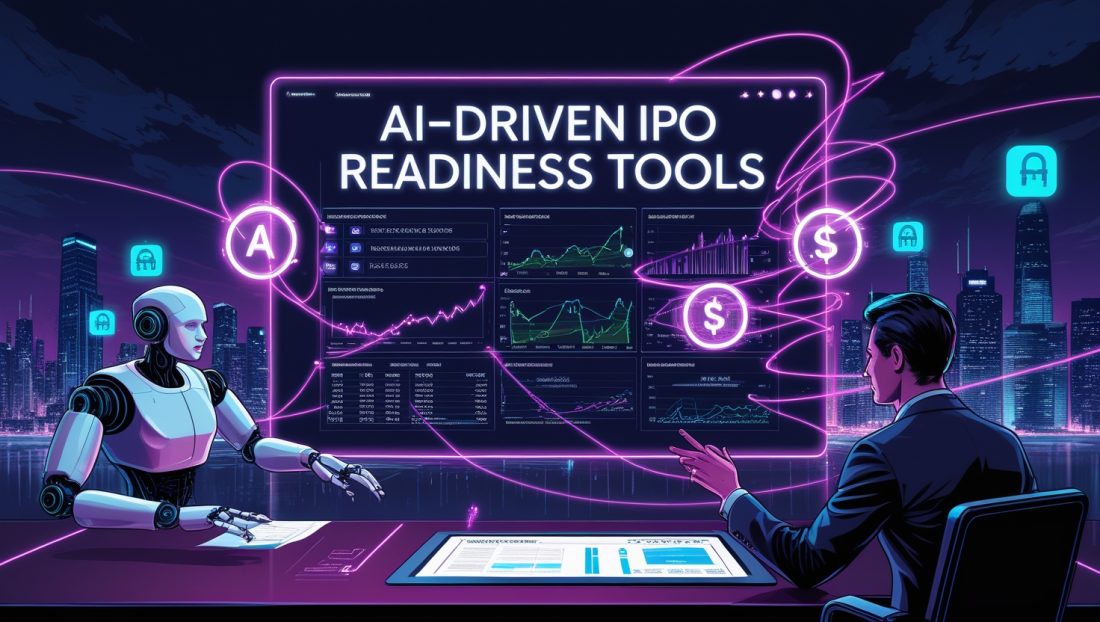Why AI Is the Non-Negotiable Catalyst for 2025 IPOs
What separates a successful IPO from a stalled offering in today’s hyper-competitive markets? The answer lies in AI-driven IPO readiness—a paradigm shift that merges predictive analytics, automated workflows, and real-time risk mitigation to transform how companies prepare for public scrutiny. With over 450 companies on file with the SEC as of May 2025 (up 75% from 2023), the race to stand out demands more than manual processes or legacy systems.
Take CoreWeave, a cloud infrastructure provider that slashed its financial close cycle by 40% using AI-driven IPO readiness tools, enabling a $35 billion Nasdaq debut in March 2025. Their success underscores a universal truth: companies leveraging AI-driven IPO readiness achieve faster audits, sharper investor narratives, and resilient valuations in volatile markets. This precision aligns with innovations like NVIDIA’s cloud-connected humanoid robots, which streamline complex data processes, offering a glimpse into how AI is reshaping high-stakes industries.
The Strategic Imperative of AI in Modern IPOs

From Spreadsheets to Predictive Intelligence
The IPO landscape has shifted from growth-at-all-costs to profitability and transparency. Investors now demand granular visibility into financial health, with 50% of Q1 2025 IPOs in the TMT sector explicitly highlighting AI-driven IPO readiness in their SEC filings. Traditional methods falter under these expectations:
- Manual Errors: Spreadsheet-driven workflows result in 12–15% data inaccuracies, delaying audits and eroding investor trust.
- Regulatory Complexity: SEC compliance now requires real-time updates on cybersecurity risks, ESG metrics, and non-GAAP reconciliations—tasks AI-driven IPO readiness automates with 99.5% accuracy.
AI addresses these gaps by unifying financial, operational, and compliance data into a single source of truth. For example, Stripe’s integration of GPT-4 into payment APIs reduced invoicing errors by 30%, accelerating cash collection cycles critical for IPO roadshows. This mirrors advancements in AI-driven automation revolutionizing grocery, where streamlined data workflows enhance operational efficiency.
3 Pillars of AI-Driven IPO Success

Pillar 1: Automated Financial Governance
AI-powered ERP systems like SymphonyAI automate reconciliations, flag anomalies, and generate audit-ready reports, compressing financial close cycles from 21 days to 7. Klarna’s cash flow models, enhanced by AI-driven IPO readiness, predict revenue with 95% accuracy—a metric that directly influences IPO pricing and investor confidence. This level of precision is akin to BMW’s humanoid robot precision manufacturing, where AI ensures flawless operational execution.
Real-World Impact:
- CoreWeave: Reduced manual reconciliation time by 60%, enabling quarterly reports aligned with PCAOB standards.
- StubHub: Used AI financial compliance tools to resolve pricing compliance issues pre-IPO, avoiding delays linked to litigation risks.
Why Automated Financial Governance Is Non-Negotiable for IPO Success
Automated financial governance, a cornerstone of AI-driven IPO readiness, eliminates human error and accelerates audit timelines. By leveraging machine learning, companies can detect discrepancies in real time, ensuring compliance with stringent SEC standards. This automation also frees finance teams to focus on strategic investor communications, much like how AI in judicial decisions enhances precision in high-stakes environments.
Pillar 2: Scenario Modeling for Market Volatility
With 70% of 2025 IPOs facing tariff uncertainties and inflationary pressures, predictive IPO analytics tools simulate over 1,000 economic scenarios to stress-test valuations. Databricks, preparing for a $62 billion IPO, uses these models to assess supply chain disruptions, interest rate hikes, and geopolitical shocks—ensuring stability even if markets dip post-listing. This predictive power parallels zero-gravity robotic manufacturing, where AI anticipates and mitigates operational risks in complex settings.
Key Metrics:
- Accuracy: AI forecasts reduce earnings miss risks by 40%, according to PwC’s 2025 Capital Markets Report.
- Speed: Generative AI drafts 80% of roadshow materials, freeing teams to refine investor narratives.
Why Scenario Modeling Is Critical for IPO Resilience
In volatile markets, AI-driven IPO readiness empowers companies to anticipate and adapt to economic shifts. By modeling countless scenarios, AI ensures valuations remain robust under stress, giving investors confidence in long-term stability. This approach is similar to AI-driven cybersecurity threat detection, where proactive risk assessment prevents costly disruptions.
Pillar 3: Compliance at Machine Speed
SEC filings now average 300+ pages, with AI financial compliance tools like CrossCountry Consulting’s platform reducing review time by 50%. These systems auto-map disclosures to regulatory requirements, flagging gaps in real time—critical for avoiding last-minute amendments that delay listings. This efficiency is comparable to robotic microfactories for on-demand manufacturing, which streamline complex processes with precision.
Why Machine-Speed Compliance Wins the IPO Race
AI-driven IPO readiness ensures compliance keeps pace with regulatory demands, reducing the risk of delays or penalties. By automating document mapping and gap analysis, companies can focus on strategic priorities, much like AI-powered regtech transforms compliance for global banks.
Case Study: How Tempus AI Redefined Healthcare IPOs
Tempus AI’s 2024 IPO showcased the transformative power of AI-driven IPO readiness. By integrating genomic data with patient records, the company:
- Automated 90% of clinical trial documentation, cutting pre-IPO due diligence time by six months.
- Used predictive IPO analytics to justify a $8 billion valuation despite market skepticism about healthcare tech.
Post-listing, Tempus’ stock surged 56%, proving that AI-driven IPO readiness directly correlates with investor confidence. This success mirrors AI-assisted artifact recovery, where data-driven precision drives breakthrough outcomes.
The Road Ahead: AI’s Role in 2026 IPOs

By 2026, Gartner predicts AI will handle 45% of IPO-related tasks, from drafting S-1 filings to simulating investor Q&A sessions. Emerging trends include:
- Quantum Computing: Accelerating data analysis for global enterprises with multi-currency exposures, as seen in quantum machine learning robotics.
- Ethical AI Frameworks: Mitigating biases in financial forecasting to align with SEC’s 2025 guidelines on algorithmic transparency, similar to AI ethics debates.
Alexis Rockenbach, CEO of AI/R, emphasizes:
AI isn’t a luxury—it’s the bedrock of modern IPOs. Firms delaying adoption risk becoming obsolete in an era where data agility defines market leadership. This urgency is evident in AI-driven model optimization, where rapid adaptation drives competitive advantage.
FAQs: Addressing Key Concerns About AI-Driven IPOs
Does AI reduce IPO preparation costs?
Yes. Automating financial close and compliance cuts pre-IPO expenses by 25–30%, according to EY’s 2025 Global IPO Trends.
What are the risks of over-relying on AI?
Bias in training data and over-automation can lead to regulatory penalties. Partner with auditors to validate AI financial compliance outputs.
How long does AI integration take?
Pilots take 3–6 months. Full deployment averages 12–18 months—aligning with optimal IPO timelines.
Prepare for the AI-Driven IPO Era
The window for 2025 IPOs is narrowing. Subscribe to our Newsletter for more breakthroughs on how to audit your financial systems, or schedule a consultation with CrossCountry Consulting’s AI-driven IPO readiness experts. For deeper insights, explore why AI in finance disrupts robo-advisors to understand how AI is transforming financial strategies across industries.
